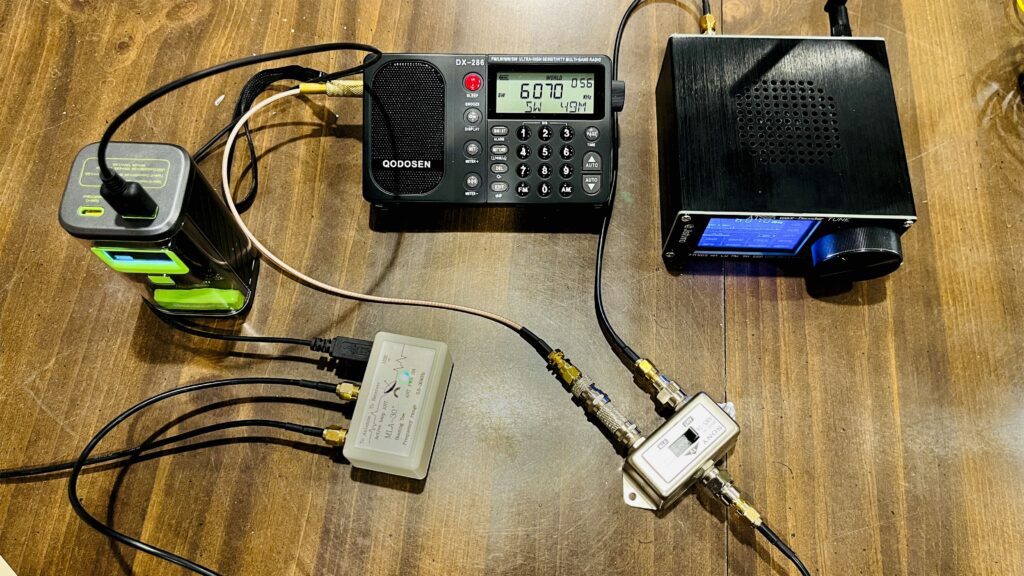So now to examine the question: how does the ATS25 Max Decoder compare with other portable radios on shortwave?
The rules are simple. An MLA-30+ amplified loop antenna will be connected to an A/B switch, which will in turn be connected to two radios. First you’ll hear the ATS25 Max Decoder and then you’ll hear another radio. I’ll try to keep the volume level the same. The recording will be made with an iPhone 13.
I live in central Virginia just about 400 miles from Toronto, Canada. One of my favorite testing stations is the commercial station CFRX whose mission is to broadcast to northern Canadian territories with little radio coverage. Time stations are good at various times of the day as well, WWV and CHU.
The Setup
On the left is a BSCANE battery supply powering the MLA-30+ Biasing Tee that feeds a SONY ANS-34 Antenna / Video Tape Recorder switch (from a time when that made sense). The switch then feeds directly to the two radios, in this case a Qodosen DX-286 and of course the ATS25 upper right.
Here’s the wiring:

Testing is simple. Just pick a radio, flip a switch and make sure the other radio is muted. Take a video.
The Validity of the Test
This is all done in an unscientific way. It just shows results with one type of antenna. It’s done at different times of the day and different frequencies. Shortwave conditions change from moment to moment. And one big issue is ambient noise from the electronics in my house. Your reception may vary. I should do this at a secluded spot, but it’s freezing outside.
Qodosen DX-286
I’ve written quite a bit about the Qodosen DX-286. It is my daily go-to radio for everything except SSB. It’s a great radio, very portable, and an outstanding performer. As hinted in the introductory photo, it was the first radio I tested. And in the other tests, I use the DX-286 to pick stations because it is sensitive and scans fast.
The time was around 01:00 UTC or 8 PM local time. I tuned toward my testing sweet spot, CFRX 6070 kHz, Toronto, and it was audible on both radios. Volume on both of these radios can be turned up pretty high, and CFRX is not a strong station. For the test, the ATS25 was turned all the way up, and the DX-286 was about 3/4 of the way up. Bandwidth was set to 3000 Hz on both radios.
Next, I chose CHU from Ottawa on 3330 kHz, and finally Vatican Radio in Spanish on 7305 kHz.
It should be evident from my test why I like CFRX for testing. It separates the good radios from the very good radios. In this case the ATS25 was the good radio, and the DX-286 clearly the very good radio.
HanRongDa HRD-757 (aka Raddy RF757, Zhiwhis ZWS-757)
The HRD-757 is one of my newer radios. It has a few gimmicks of interest; broad coverage (including AIR band, Weather Alerts and VHF/UHF), recording to a micro SD card, phone app control, and operation as a Bluetooth speaker. In stark contrast with the DX-286, this is a radio I rarely use except to test something. It’s not a bad radio, but I have better. It lacks a bandwidth control. The ATS25 bandwidth is set at 3000 Hz, as in all the tests.
Things got weird and my comparisons made no sense. Bernard Binns, listed first on the credits on the ATS25 Info screen said in a video how frustrating it was to spend half an hour with the radio and not hear much of anything, only to find out that the antenna switch was in the wrong position (always use AUTO). This was a similar experience, only the HRD-757 DX/Local switch was in the Local position. Toss out all that video.
In the tests that follow, the ATS25 Max Decoder volume control was set to its maximum value of 63, while the HRD-757 volume control was set to 22 out of 32. It could have been turned up much louder.
Sihuadon R-108
The Sihuadon R-108 radio is good value for its price range, a solid contender with added AIR band.
XHDATA D-109WB
I used an XHDATA D-109 for a while, until better radios came along. In this test I used the very similar D-109WB variant with weather band. It has an above average speaker and is reasonably sensitive. The speaker is more responsive to lower tones. It can overload in a strong signal area, but that’s not a problem in my rural location.
XHDATA D-808
This seems to be a pretty standard radio with wide distribution. It’s a solid performer with AIR band and SSB. I’m personally not a fan of the controls, so I don’t use it much.
LiJiANi Rd239
Besides the ATS25, this is my only other radio that boasts user-installable firmware updates. Functionally, it’s similar to the HRD-757, but the flashlight is brighter.
Eton Elite Executive (aka Grundig Elite Satellit)
This a wonderfully designed radio and a sheer pleasure to operate. It supports SSB and AIR band.
Tecsun PL-330
This has been my go-to travel radio for some time because of it’s superior band scanning ability with the bonus of SSB.
Tecsun PL-990
The Tecsun PL-990 is arguably my best radio (and the most expensive one). It’s sensitive on all bands. We’ll give it a ride here.

